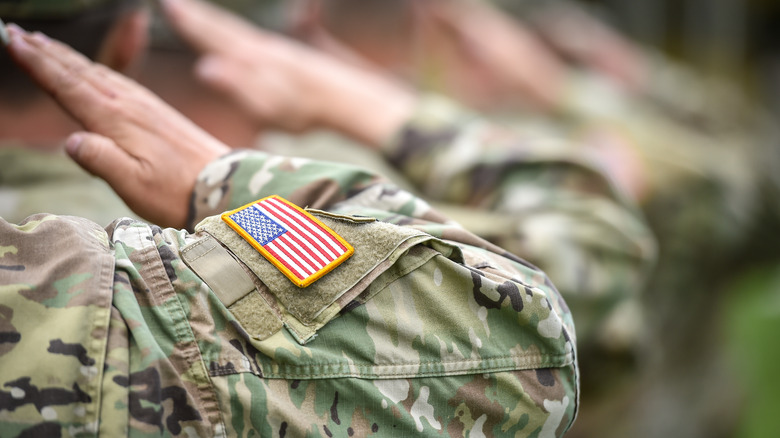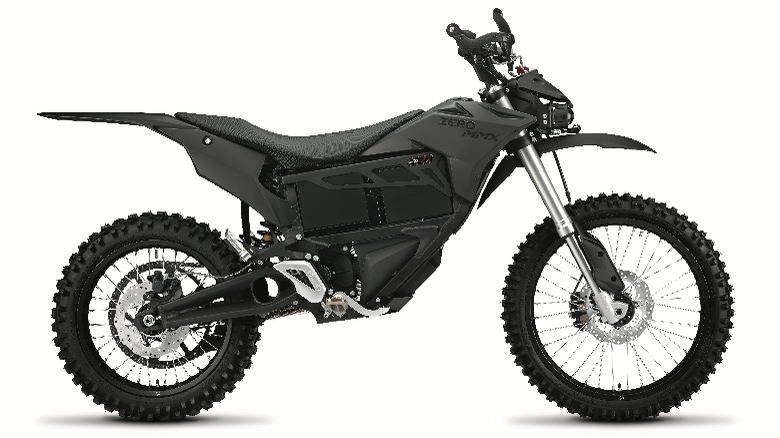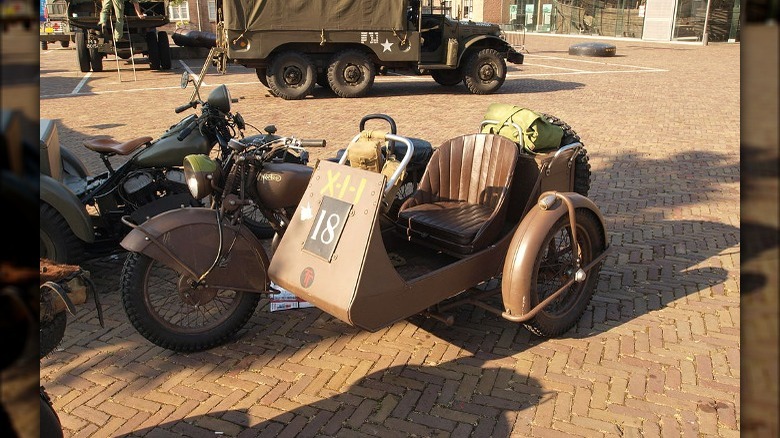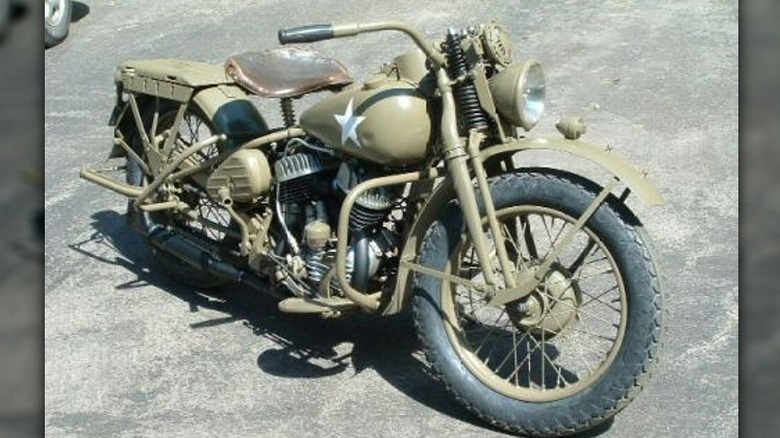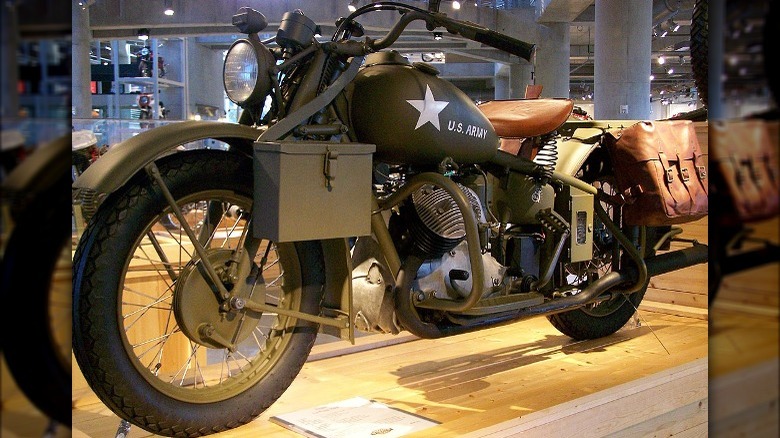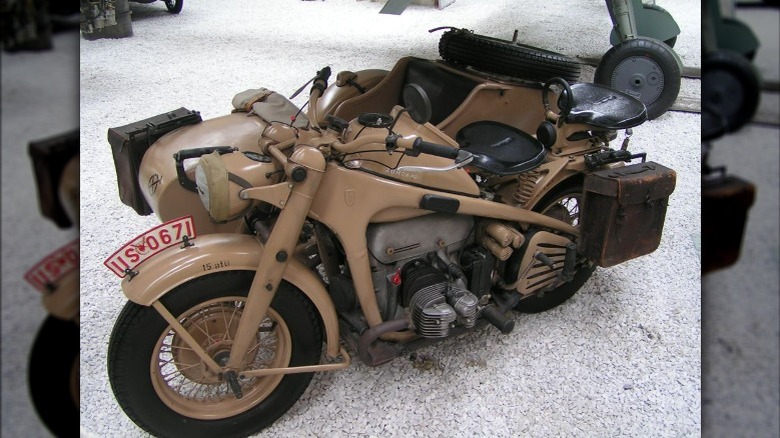5 Of The Most Iconic Military Motorcycles Of All Time
Military motorcycles are a thing of beauty — they must be customized for heavy-duty use and reliability. Military applications demand that motorcycles perform in all conditions and without hesitation. Failure could mean the difference between life and death, after all. A commuter motorcycle may have all kinds of features and a powerful engine, but performance is typically road-based and doesn't account for the potential for routine gunfire or a need to survive being dropped out of an airplane.
Militaries worldwide have relied on the motorcycle for fast, agile transportation. Shuttling messages between camps or scouting are often a job for these speedy and highly mobile vehicles. Motorcycle riders have also been known to participate directly in battle, with heavier motorcycle builds carrying a sidecar that has often sported the classic machine gun mount alongside the passenger.
Across the board, military motorcycles are some of the most fascinating pieces of equipment that service members use regularly. They can appear so pedestrian in their construction, but make no mistake; these specialized transportation tools are built for the most challenging jobs. These are five iconic models that have ever spent time on the battlefield or doing the essential fieldwork just behind it.
Zero MMX
Perhaps an unconventional starting point, the Zero MMX is nonetheless an icon of modern military mobilization. The MMX model is the product of Zero Motorcycles and only came into being a decade ago, in 2013. The Zero MMX is a platform specifically tailored to the unique needs of the United States military. The motorcycle is essentially a dirt bike complete with offroad tires. But where the MMX diverges from expectation is in its electric power. The Zero MMX is painted in an aggressive black matte but makes almost no noise -– a significant departure from what'd you'd expect when seeing this bike.
The 2023 MMX motorcycle weighs 275 pounds, easily transported into a combat theater. It can achieve a top speed of 85 miles per hour through an electric motor that produces 46 horsepower and 78 ft-lb of torque. According to the company's product brochure, the unit can handle a 45- to 155-minute "aggressive tactical riding" session and costs just 81 cents to recharge the battery on average. The Zero MMX offers keyless ignition and a modular power design that allows users to carry additional battery packs for a quick swap if additional range is required.
Norton WD Big 4
Norton was a primary driver of military motorcycle production for the British army and its allies during both World Wars. The Norton WD Big 4 motorcycle was built between 1907 and 1954 and was named after the four-horsepower the bike initially produced. These motorcycles showcase an iconic visual design intertwined with the era's military aesthetic. The Big 4 was typically painted in a classic matte green shade and utilized a sturdy frame lacking any backend suspension. The result was a somewhat bumpy ride, but a motorcycle that could perform over virtually any terrain the battlefield could throw at a driver.
British forces utilized the WD Big 4 as a resupply option that could reliably bring ammunition and soldiers to the front without incident. The motorcycle could support two or three soldiers (depending on whether the sidecar was attached) and a full outfit of equipment. The sidecar could also be outfitted with a machine gun or removed to support additional equipment carriage instead of a third rider. A 633cc engine powered the motorcycle, and Norton built around 4,700 WD Big 4s, complete with a sidecar, during World War II alone. This classic motorcycle is a heritage piece of definitive military motorcycle technology, to be sure.
[Featured image by AlfVanBeem via Wikimedia Commons | Cropped and scaled | CC0]
Harley-Davidson WLA
Harley-Davidson's WLA model is an icon of American military engineering and the crown jewel of classic military motorcycles. The vehicle was designed specifically for European warzones and to perform in the thick of battle.
Harley-Davidson built more than 90,000 WLAs for the U.S. military during World War II, and the bikes were used in virtually every situation you could imagine. WLAs were made with a 740cc, 45-degree V-twin engine. The powerplant could produce 25 horsepower, and paired with the WLA's three-speed transmission, the motorcycle could traverse all terrain. The WLA was often equipped with large saddlebags, an ammunition box, and even a rifle scabbard ahead of the handlebars for the option to shoot on the move if a situation required it.
The Harley-Davidson WLA is an American military icon. Still, versions of the platform were also piloted by Canadian, British, and even Soviet troops during the war through the U.S. lend-lease program.
[Featured image by Jccooper via Wikimedia Commons | Cropped and scaled | Public Domain]
Indian Model 841
Another American-made motorcycle, the Indian Model 841 is a prime example of essential military equipment in the history of American battlefield performance. The 841 was built specifically to turn the tide of war in North Africa. The Axis coalition spent significant resources and energy in this conflict region. Nazi forces used the BMW R71, yet another high-performance, WWII-era motorcycle, and the Allies needed something to oppose it.
After significantly contributing to the war effort a few decades earlier, Indian built 1,000 examples of the 841 motorcycle for use in desert terrain. The bike ran on a 737cc 90-degree V-twin engine and a four-speed transmission. Ultimately, the Army opted for a different course than the Indian or Harley-Davidson experimental models, and Indian turned to the consumer market for the bikes it had produced. This gives the 841 a unique crossover appeal for those enthralled by military history and who love motorcycles. The 841 is a purpose-built machine that was engineered specifically to take on Nazi dominance in the desert but instead became accessible to the open market.
[Featured image by Chuck Schultz via Wikimedia Commons | Cropped and scaled | CC BY-SA 2.0]
Zündapp KS 750
The last motorcycle on this list doesn't come from the Allied forces. Instead, the final entry is a German production that has become even more iconic than the technologically advanced BMW R71. The Zündapp KS 750's inclusion here is due to its prominent role in pop culture since the end of these generational conflicts with Germany. The Zündapp KS 750 is unmistakably the motorcycle that Indiana Jones and his father escape from Castle Brunwald during the classic motorcycle chase scene in "Indiana Jones and the Last Crusade." The bike is revived nearly any time a movie production crew needs to add the Nazi faction into their screenplay.
The Zündapp KS 750 was powered by a 745cc OHV four-stroke engine that produced 26 horsepower and was paired with a four-speed gearbox. The German army utilized the bike across virtually all fronts, from North Africa to France and Russia. German riders could mount a machine gun to the sidecar, and the driver could pull multiple small trailers behind the vehicle for resupply purposes. This motorcycle was a mainstay for the German military as an all-purpose vehicle and has continued to enjoy a prominent position in the cultural understanding of the conflict.
[Featured image by Stefan Kuhn via Wikimedia Commons | Cropped and scaled | CC BY-SA 3.0]
